Abstract
Despite extensive research on what draws people to urban streets, most existing insights originate from Western contexts, offering limited perspectives from wider urban contexts. This study addresses this gap by examining everyday street activities in Chinese urban villages, focusing specifically on how two spatial scales, the entire street edge and territorial segments, influence necessary, optional, and social engagements. Drawing on video recordings and walk-by observations in two urban villages in Wuhan, China, the research systematically measured the type and duration of activities across 110 territorially defined segments. The findings reveal that territorial segments, i.e., smaller-scale personalised subdivisions at a micro-scale often shaped by bottom–up adaptations, exert a significantly stronger influence upon how people use and linger in street space rather than entire street edges at a macro-scale, which shows only limited impact. This underscores the importance of fine-grained socio-spatial design and local ownership in fostering vibrant people-centred streets. By demonstrating the decisive role of micro-scale features, which span storefront layouts, semi-public alcoves, and adaptive uses, these results carry important implications for urban practitioners seeking to balance top–down redevelopment with bottom–up initiatives. Ultimately, the study enriches the global discourse on street-edge understanding and design, emphasising that territorial segments can be powerful catalysts for promoting activity and community life in dense urban contexts.
1. Introduction
Over recent decades, Chinese urban development has been characterised by predominantly top–down, economically driven practices [1,2]. This has resulted in a suppression of bottom–up actions while limiting people’s ‘right to the city’, in line with individual and communal use and the adaptation of environments to suit their everyday needs [3]. Such dynamics are especially visible in the regeneration of Chinese urban villages, often identified as informal settlements embedded within rapidly expanding urban centres [3,4]. Beyond providing affordable housing and social agencies for migrants [5,6,7], these villages have recently undergone large-scale, top–down redevelopment, spearheaded by powerful institutions and private companies [3,8,9]. Consequently, homogenising design approaches, which often prioritise demolition and reconstruction, have overshadowed more community-oriented strategies, eroding local social vitality and public engagement [8]. Despite these pressures, bottom–up activities and personalisation persist in Chinese urban villages, contributing to rich, vibrant street life [10].
Within this context, the current study focuses on how people use urban village streets, specifically how everyday activities are influenced by different scales of street edges. Street edges exist at the interface between inside and outside (see Figure 1) and often shape users’ inclination to pause, socialise, engage with, and use ground-floor functions [11,12,13]. Their composition emerges from both top–down interventions (e.g., major façade redevelopments) and bottom–up appropriations (e.g., small-scale personalisation) [14,15]. In Chinese urban villages, street edges have undergone substantial restructuring at both the macro-scale (entire edges) and micro-scale (small ‘territorial segments’) [16]. Understanding how these scales impact residents’ everyday engagement is critical, especially given the tension between large-scale planning and fine-grained local adaptations.
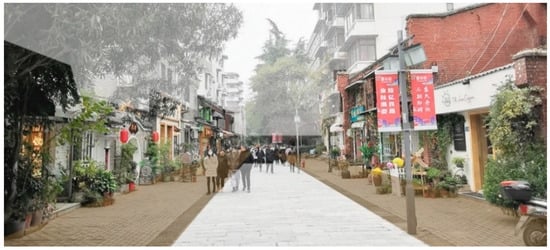
Figure 1.
Street edges (source: photographed and diagrammed by author).
1.1. Street Edges and Territorial Segments
Street edges often serve as transitional spaces, linking the interiors of buildings with the public realm; they are “soft edges” [12]. Gehl et al. [15] emphasised how these spaces can foster social opportunities and provide daily contact opportunities [12,16]. By contrast, when ground-floor interfaces lack variety or human-scale features, they can appear hard, flat, and inhospitable, dampening pedestrian engagement [16,17,18]. Within Chinese urban villages, street edges exhibit a dual form of top–down and bottom–up restructuring. On one hand, large segments may be demolished and rebuilt under state-driven or private initiatives. On the other hand, individuals adapt smaller-scale subdivisions through territorial occupation, appropriation, and personalisation [19,20,21].
These subdivisions are often referred to as territorial segments (Figure 2). They encompass varied socio-spatial attributes (e.g., shops, restaurants, and semi-public alcoves), demonstrating how personalisation, ownership, and physical form come together to shape street vibrancy [22,23,24]. As Mehta and Mahato [19] highlight, local interventions, like adding seating or decorative elements, can foster lingering and social contact. Yet, urban designers and segment owners often overlook such nuanced scales, particularly in Chinese contexts, treating them merely as building structures [25,26,27]. Consequently, social vitality and sense of place can be inhibited, pointing to a crucial gap. Few studies have explored how street edges and territorial segments influence the everyday activities that are fundamental to community life [27,28].

Figure 2.
Territorial segments (divided plinths and manifested through personalisation and ownership) (source: photographed and diagrammed by author).
1.2. Activities and Their Relevance to Urban Villages
Urban scholars frequently emphasise that varied activities, spanning everyday necessary, optional, and social actions, are central to street vibrancy [15,29]. Necessary activities (e.g., daily shopping or commuting), involve limited choice in location or timing. Optional activities (e.g., standing, observing, and ambling) depend upon environmental comfort and individual preference. Social activities (e.g., conversing, greeting) often emerge from these other two categories when conditions support collective interaction. In Chinese urban villages, however, the influence of top–down, large-scale interventions is starting to result in rigid street edges and high vehicle dominance, frequently limiting such activities and leading to the diminishment of street life [10,30,31]. Alongside this, a more fine-grained understanding of how street edges and territorial segments facilitate or inhibit these activity types remains underexplored.
1.3. Research Gap, Objectives, and Research Questions
Much of our existing knowledge of street-edge dynamics is derived from Western contexts [13,14,15]. Chinese urban villages offer a markedly different setting, shaped by intense redevelopment and layered top–down vs. bottom–up practices across different scales. However, how everyday activities fit into these transformations is not well documented. To address this lack of understanding, the present investigation focuses on two street-edge scales, the overall street edge and its territorially defined segments, and examines how each influences necessary, optional, and social activities.
Building on the background and gaps identified, this study aims to investigate how different scales of street edges, from the overall interface between buildings and public space to the more finely grained territorial segments, influence the nature and duration of everyday activities within Chinese urban villages. In so doing, it addresses three key objectives:
- (i)
- to examine the extent to which entire street edges influence people’s engagement in necessary, optional, and social activities;
- (ii)
- to evaluate whether, and how, smaller territorial segments exert a different or more localised effect on these same activity types;
- (iii)
- to explore the interplay between necessary, optional, and social activities at both street-edge and territorial-segment scales, thereby identifying any overlaps or divergences in how users occupy these public interfaces.
In line with the above objectives, we formulate two overarching research questions:
- Research Question 1 is: does the duration of different activity types (necessary, optional, and social) vary in the Chinese urban village context when examined at the scale of (i) street edges, and (ii) the scale of territorial segments?
- Research Question 2 is: is there a relationship between the duration of different activity types (necessary, optional, and social) in the Chinese urban village context when considered at (i) street edges and (ii) the scale of territorial segments?
By contrasting the macro-scale (entire street edges) and the micro-scale (territorial segments), the study clarifies whether large-scale, top–down designs sufficiently account for everyday uses or if smaller-scale, bottom–up adaptations prove more decisive in shaping street vibrancy. Ultimately, this dual focus aims to extend our theoretical and practical understanding of urban villages, offering insights relevant to both Chinese and global contexts, where rapid redevelopment intersects with local agency.
2. Materials and Methods
2.1. Research Design
This study adopts an exploratory, mixed-method approach. Specifically, we employed video recordings, walk-by observations, and extensive field notes to capture both the quantitative and qualitative nuances of everyday activities along urban street edges and the territorial segments that subdivide them. By systematically measuring the type and duration of activities, while also documenting user behaviours, social interactions, and spatial adaptations, this mixed-method strategy provides a rich contextual understanding of how people engage with these ground-floor interfaces. To support representativeness, we selected study sites that exhibit a range of building typologies, user demographics, and socio-spatial conditions that are typical of Chinese urban villages. Although the research design does not involve controlled experimental conditions or random assignment, it is well-suited for capturing emergent patterns in real-world settings. Through the triangulation of diverse sources of evidence, the project ensures a robust exploration of street-edge dynamics, generating findings that inform both academic discourse and practical urban design interventions.
2.2. Street Selection and Subdivision
Wuhan was chosen as the overall study area because it is one of China’s largest megacities and the capital of Hubei Province, where land redevelopment of urban villages began in 2004 [32]. Over 80% of its urban villages have been transformed into new urban communities [33], drawing upon both state-oriented and community-driven redevelopment models [8,34,35]. These overlapping approaches make Wuhan highly relevant for exploring how top–down and bottom–up processes intersect at different scales of street edges.
From Wuhan’s numerous urban villages, we selected Tan Hualin and Si Menkou because they combine rich history, mixed-use functions, and vibrant urban fabrics that reflect the city’s broader redevelopment patterns. Across these two villages, six streets were chosen, three in Tan Hualin and three in Si Menkou (Figure 3). Within each village, we included one leisure-oriented street (featuring more historical architecture or recreational attractions) and two everyday-oriented streets (primarily serving local residential and commercial needs). The specific criteria guiding selection were:
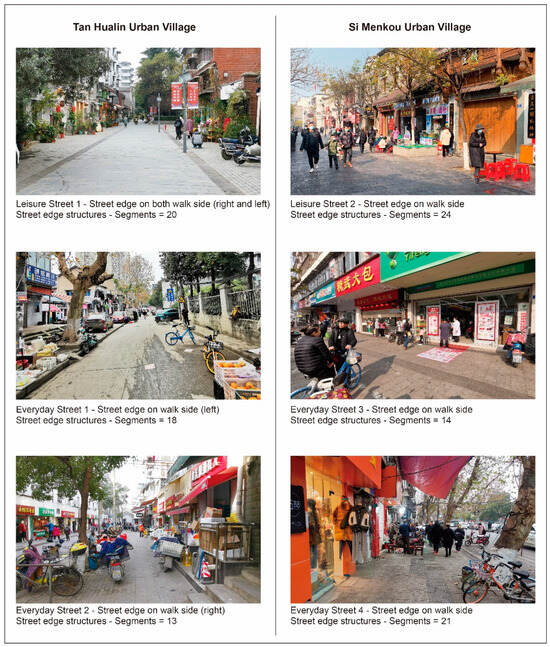
Figure 3.
Street edges of urban villages (source: photographed by author).
- -
- Mixed-use diversity: the two urban villages contain retail, residential, and commercial functions, producing a varied pool of potential street users;
- -
- Material properties: each street offered distinct physical characteristics and affordances, reflecting diverse building types and façade treatments;
- -
- Spatial features: differences in spatial porosity and lateral depth (e.g., segment setbacks or projections) provided a range of configurations for human activity;
- -
- Variety of social interaction: we sought streets supporting necessary, optional, and social activities, ensuring a comprehensive assessment of how different street-edge scales influence user engagement.
All six selected street edges are major commercial thoroughfares within their respective villages and are lined with small, independently owned businesses, such as cafés, restaurants, and grocery stores. Although both Tan Hualin and Si Menkou fall under similar regulatory frameworks, they exhibit differing spatial arrangements, material compositions, and social capacities, traits that offer a representative and substantial sample from which to explore street-edge engagement.
2.3. Apparatus
We used smartphones (Huawei Mate 20 Pro [Huawei Technologies Co., Ltd., Shenzhen, Guangdong Province, China], iPhone XS [Apple Inc., Cupertino, California, United States]) to record videos and take photographs of street users’ behaviours. This unobtrusive setup minimised disruptions to natural activity patterns. Adobe Premiere Pro 2020 (Version: 14.0.3.1) was subsequently used to process the recordings, exporting individual video clips for each observed activity and measuring the precise duration. Ethical approval for data collection was obtained from the Department of Landscape Architecture, The University of Sheffield (Reference Number: 036596).
2.4. Video Recording
To capture everyday activities across both street edges and territorial segments, we conducted 15 min recording sessions in the morning, afternoon, and evening. Each of the 110 segments identified (distinct territorial subdivisions along the six streets) was recorded at least once during each time slot, ensuring coverage of different peak and off-peak periods. We focused primarily on prolonged activities (e.g., sitting, socialising, and browsing), excluding passersby who merely walked through without stopping.
2.5. Walk-By Observations
In parallel with video recordings, we performed walk-by observations, supported by detailed field notes. This approach allowed us to document the location, behaviour, and duration of activities on site plans, even in segments not directly visible from the camera’s vantage point. For example, if the camera was set on Segment 1 but children were playing farther down at Segment 10, the researcher could immediately note this additional activity. Observations were typically undertaken between 8:30 A.M. and 7:00 P.M. from December 2020 through February 2021, generating a robust data set that integrates direct recording with broader contextual insights.
2.6. Data Processing, Coding, and Analysis
Using the combined video and observational data, we identified the duration of different behaviours within each territorial segment (Table 1). Reliance on raw recordings enabled precise measurement of activity times, going beyond mere identification of activity types. In total, 6576 activity instances were coded, spanning necessary (n = 1557), optional (n = 2462), and social (n = 2557) categories. This classification follows standard practice in urban studies [13,29], offering a balance between comprehensive coverage and manageable complexity.

Table 1.
Behaviours of each activity type.
We distinguished two primary street-edge scales for analysis:
- -
- Entire street edge: structurally defined by the continuous interface from building façade to street realm;
- -
- Territorial segments: subdivisions defined by personalisation, ownership, or function, often manifesting in unique façade treatments, open-front shops, or small “alcove” spaces [16,17].
All statistical analyses were performed in SPSS (Version: 28.0.0.0). We applied the Kruskal–Wallis test to examine whether there were significant differences in activity durations by street edge and segment scale (Research Question 1). We then used Pearson correlations and linear regression models to assess the relationships between the three activity types at each scale (Research Question 2), measuring how necessary, optional, and social activities might reinforce or displace one another. The p-values and R2 metrics (indicating model fit) were generated from these tests, providing a quantitative foundation for the subsequent discussion of how everyday engagements manifest at different street-edge scales.
3. Results
3.1. Variation in Activity Duration Across Street Edges and Territorial Segments (RQ1)
3.1.1. Street Edges
We first examined whether the duration of necessary, optional, and social activities varied at the macro-scale of entire street edges. Figure 4 presents the average duration (in seconds) for these three activity types across the six street edges (LS—leisure street; ES—everyday street). Statistically, there were no significant differences among the edges for necessary (p = 0.14), optional (p = 0.16), or social (p = 0.32) activities. Although some edges (e.g., ES4) displayed slightly higher average durations for necessary tasks, these variations did not reach statistical significance.
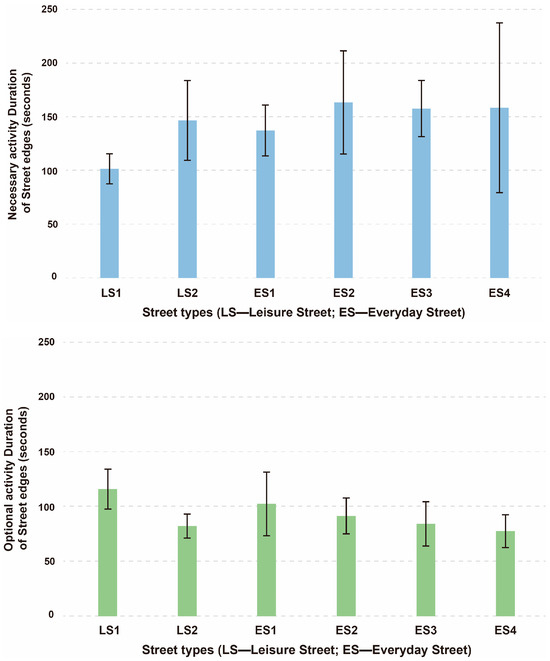
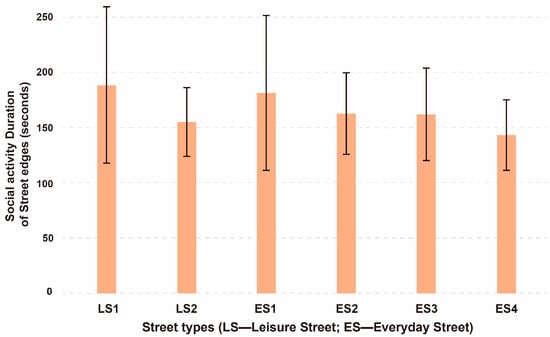
Figure 4.
The influence of differing activities upon the duration of engagement with six street edges. Error bars represent 1 standard error around the mean (LS—leisure street, ES—everyday street).
Necessary activities ranged from approximately 102–158 s, with overlapping error bars indicating minimal variance among edges. Optional activities similarly overlapped (around 77–116 s), suggesting that street-edge-scale factors alone do not strongly dictate the duration of these discretionary behaviours. Social activities, though measured between 143–188 s, also failed to exhibit significant differences at this scale.
Taken together, these results imply that treating an entire street edge as a uniform entity provides limited explanatory power regarding how long people engage in each activity type. Large-scale uniformities (e.g., continuous façades or broad planning schemes) may set an overall framework but do not necessarily determine prolonged use for necessary, optional, or social tasks.
3.1.2. Territorial Segments
We assessed whether the duration of each activity type varied at the micro-scale of territorial segments. Figure 5 shows the average duration for necessary, optional, and social activities within territorial segments across the same six streets. The Kruskal–Wallis results indicate significant differences for necessary (p = 0.01) and optional (p = 0.04) activities, but no significant difference for social (p = 0.32).
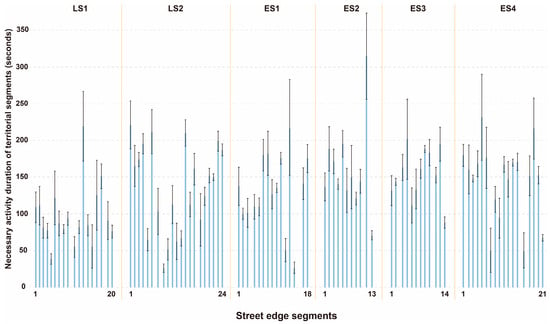
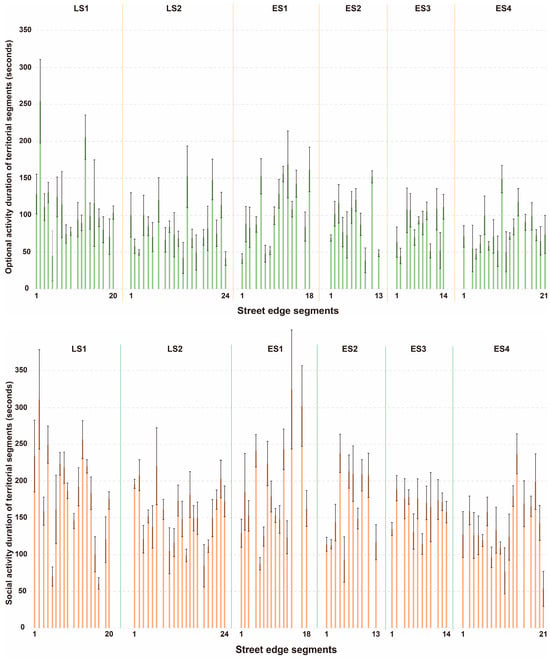
Figure 5.
The influence of differing activities upon the duration of engagement with territorial segments. Error bars represent 1 standard error around the mean (LS—leisure street; ES—everyday street).
The necessary duration spanned from 0–314.35 s, indicating that certain segments strongly encourage prolonged tasks (e.g., shopping or working) while others do not. Optional duration, ranging from 0–252.27 s, suggests that some segments are far more welcoming (e.g., shaded seating, interesting displays) than others. Social duration reached up to 323.75 s, though this did not differ significantly among segments, possibly reflecting the tendency for social interactions to occur broadly across many micro-environments.
These findings underscore that territorial segments, often shaped by individual ownership, personalisation, and spatial adaptations, exert a greater influence on necessary and optional activities than the street-edge scale. In practice, segments featuring inviting façades or flexible layouts (e.g., café seating, interactive storefronts) more effectively promote extended stays, highlighting the importance of fine-grained physical and social factors in encouraging prolonged engagement.
Collectively, the results confirm no statistically significant differences at the street-edge scale, suggesting that macro-level uniformities have limited bearing on activity duration. By contrast, the significant variance in necessary and optional durations at the segment scale demonstrates the impact of localised design and bottom–up adaptations.
3.2. Relationships Among Activity Types at Street Edge and Segment Scales (RQ2)
3.2.1. Street Edges
We investigated whether relationships exist among the durations of necessary, optional, and social activities at the street-edge scale. Figure 6 illustrates the regression and correlation results across the six street edges. For necessary vs. optional (R2 = 0.73, p = 0.03), a negative relationship suggests that edges supporting longer necessary durations (e.g., errand-focused) tend to have shorter optional durations, possibly reflecting a functional or utilitarian profile. For optional vs. social (R2 = 0.94, p < 0.01), a strong positive relationship indicates that edges where people linger for optional activities also see higher social engagement. For necessary vs. social (R2 = 0.65, p > 0.05), no significant correlation emerged, suggesting that streets with longer necessary tasks do not necessarily exhibit higher (or lower) social involvement.
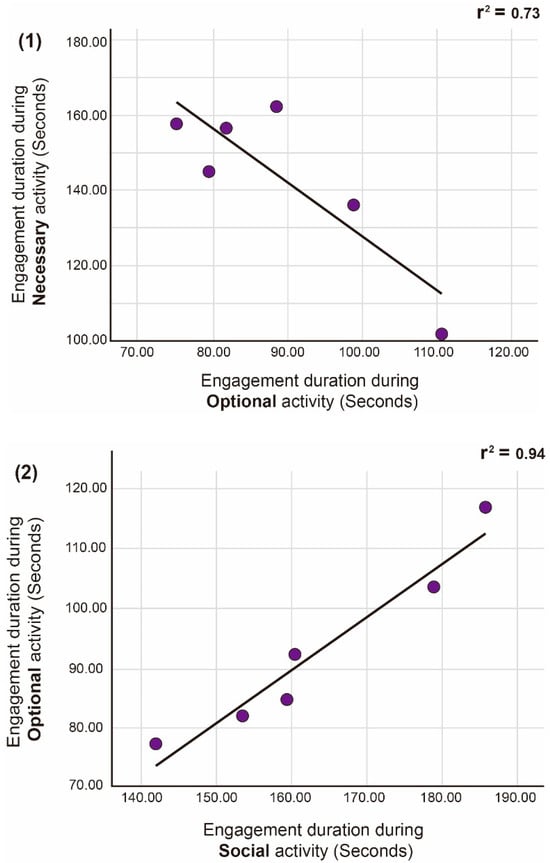
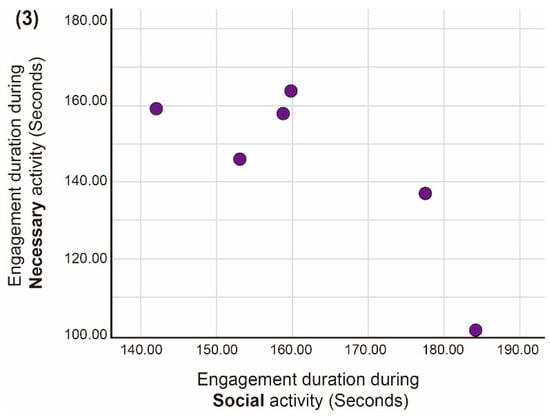
Figure 6.
The relationship between the duration of (1) necessary and optional activity engagement; (2) optional and social activity engagement; and (3) necessary and social activity engagement with street edges. Each point is the average duration for activity engagement with one street edge.
These patterns reinforce the idea that street edges considered at a macro-scale cater to different activity mixes depending on broader usage. Edges with a robust necessary function may not support optional activities, while those conducive to optional lingering can more readily convert into social interactions.
3.2.2. Territorial Segments
Figure 7 presents analyses at the territorial-segment scale, revealing significant positive relationships among all activity–type pairs. For necessary vs. optional (R2 = 0.23, p < 0.01), segments that accommodate longer necessary tasks (e.g., extensive shopping) also promote optional engagement (e.g., browsing, ambling). For necessary vs. social (R2 = 0.30, p < 0.01), segments conducive to extended necessary activities may foster social interactions (e.g., incidental conversations or waiting areas). For optional vs. social (R2 = 0.51, p < 0.01), a moderate-to-strong positive relationship indicates that flourishing optional activities frequently dovetail with social engagement, showcasing the catalytic effect of comfortable, inviting micro-spaces.
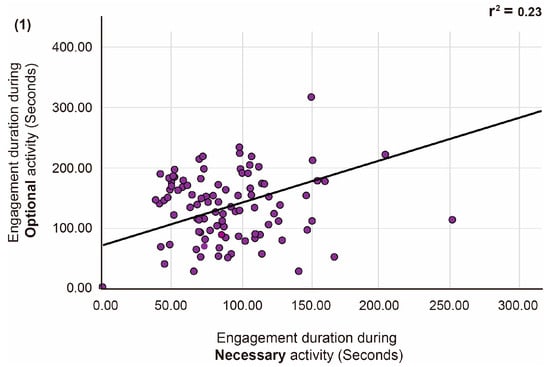
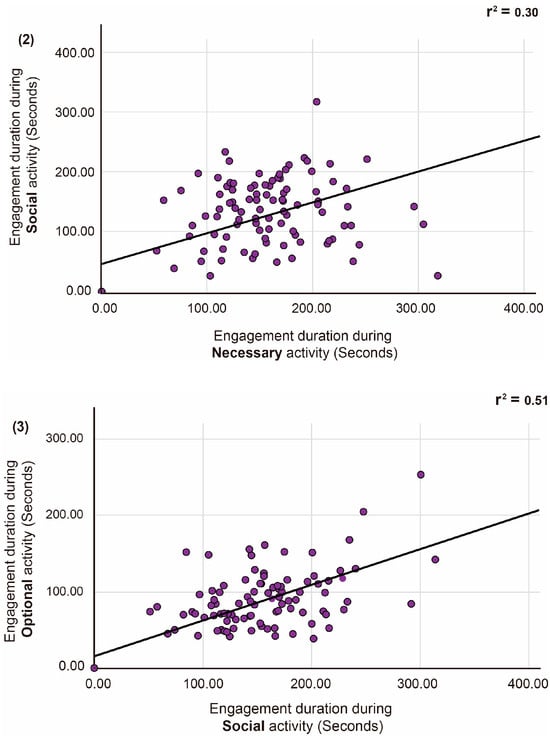
Figure 7.
The relationship between the duration of (1) necessary and optional activity engagement; (2) necessary and social activity engagement; and (3) social and optional activity engagement with territorial segments. Each point is the average duration for activity engagement with one street-edge segment.
These segment-level correlations highlight how localised design and ownership elements naturally encourage multiple activity types to overlap. For instance, a café with seating not only serves necessary needs (e.g., buying goods) but also facilitates optional loitering and social interaction, reflecting the multifunctional character of these smaller, territorialised spaces.
Overall, at the street-edge scale, the relationships among activity types are mixed, with necessary and optional exhibiting a negative correlation, optional and social being strongly positive, and necessary and social showing no significant link. Conversely, at the segment scale, all pairs of activities display positive correlations, suggesting that well-activated segments can simultaneously accommodate necessary, optional, and social actions.
4. Discussion
This study set out to investigate how different street-edge scales, spanning the entire street edge (macro-scale) and its smaller territorial segments (micro-scale), influence everyday activities (necessary, optional, and social) in Chinese urban villages. Consistent with prior work on street-edge dynamics mostly derived from Western contexts [16,17] our findings demonstrate that, although street edges provide an overall structural framework, they have no strong effect on activity duration (Figure 4). By contrast, territorial segments, often shaped pre-dominantly by bottom–up interventions, show a significant impact on necessary and optional engagements (Figure 5). This disparity aligns with research indicating how finer-grained design features, such as physical form, ownership, or adaptive uses, can be more decisive in fostering diverse, longer-lasting uses of urban space [16,23]. Highlighting where and how these segments encourage extended stays underscores the importance of localised interventions for cultivating a vibrant, inclusive street life in contexts where top–down strategies have often overshadowed community-oriented approaches [3,8,9], particularly in the context of Chinese urban villages.
4.1. Street-Edge Scales and Everyday Activities
Addressing RQ1, the results indicate that street edges, treated as singular entities at a macro-scale, display no significant differences in how long people participate in necessary, optional, or social activities (Figure 4). This finding suggests that large-scale uniformities, like continuous façades or comprehensive redevelopment schemes, may not fully capture how people linger in these spaces, corroborating earlier claims that top–down interventions alone might overlook fine-grained dynamics [36,37,38]. Indeed, macro-level edges geared toward necessary functions (e.g., errands or deliveries) can inadvertently suppress optional activities while not necessarily supporting social interactions (Figure 6). These observations echo the notion that a broad-scale design focus, while important for general urban infrastructure, may not guarantee an active street life if localised needs remain unaddressed [36,39].
In contrast, territorial segments (often personalised subdivisions at a micro-scale), emerge as the decisive factor in shaping necessary and optional engagements (Figure 5). In line with RQ1, we see significant variance in activity durations often linked to local ownership, adaptive uses, and bottom–up modifications. For instance, features like seating, distinct façade treatments, or shopfront layouts can encourage more prolonged stays, which is consistent with scholarship emphasising human-scale design [12,15,17]. Although the lack of a statistically significant difference for social durations (p = 0.32) might reflect the ubiquitous nature of socialising across multiple segments [17,29], the strong effect of territorial segments on necessary and optional tasks nevertheless highlights how micro-scale interventions can significantly influence daily street usage.
Turning to RQ2, the results show mixed patterns for activity relationships at the street-edge scale (Figure 6), whereas territorial segments exhibit consistently positive correlations among necessary, optional, and social tasks (Figure 7). This suggests that micro-scale settings commonly allow multiple activities to co-occur. For instance, segments conducive to extended shopping (necessary) may also promote optional lingering and social exchanges. By contrast, edges heavily oriented toward necessary functional tasks can dilute or even displace these activities. Such distinctions resonate with Jacobs’ [40] emphasis on neighbourhood diversity that is responsive to the human scale and Gehl’s [12] call for people-centred design while capturing the specific Chinese urban village context in which top–down redevelopment intersects with bottom–up personalisation [3,8,23].
Overall, these findings clarify the complementary yet distinct roles of street edges and territorial segments in Chinese urban villages. Entire street edges may offer an overarching structure but do not strongly dictate activity duration; micro-scale segments, on the other hand, appear far more potent in encouraging necessary and optional tasks, with positive spillovers for social engagement. As such, micro-scale flexibility facilitates multiple activity types to flourish simultaneously, reinforcing the importance of smaller territorial subdivisions in sustaining a dynamic, people-centred public realm [39,40].
4.2. Practical and Theoretical Implications
Our findings hold significant relevance for planners, policy-makers, and urban designers operating in rapidly evolving contexts, such as Chinese urban villages [3,4,8,9]. On a practical level, owners of territorial segments can foster levels of engagement, spanning overlapping necessary, optional, and social activities, by tailoring their small spaces, introducing seating, or adopting other design elements that invite people to linger, aligning with ideas presented by Thwaites et al. [23] and Gehl et al. [15]. Such localised interventions transform individual street patches into compelling micro-hubs for prolonged engagement, validating Mehta and Bosson’s [39] emphasis on personalisation as a key driver of public life.
In parallel, policy-makers can offer incentives or establish guidelines that encourage such micro-level interventions. Flexible zoning regulations or façade-improvement grants, for example, might support smaller-scale personalisation rather than enforcing uniform or homogenising standards. This approach acknowledges the importance of bottom–up adaptations, reflecting the fact that user-driven modifications frequently catalyse dynamic public life [23,37]. Consequently, urban designers would benefit from conceptualising the street edge as a collection of socio-spatial modules, each capable of hosting multiple behaviours and adaptive uses, instead of viewing it as a single, monolithic boundary. Such a perspective aligns with arguments made by Simpson et al. [16] in relation to UK high streets.
From a theoretical perspective, this focus on locally responsive design aligns with the scholarship on “soft edges” [12,15,23], highlighting how user-driven modifications enhance public life by introducing layers of interest and flexibility. By anchoring these ideas within the Chinese urban village context, the study extends Western-derived theories, such as the seminal work of Gehl [12] and other researchers looking at street edges [16,23], to situations where top–down imperatives (e.g., large-scale demolition and reconstruction) often coexist with localised ownership and adaptive place-making. Through this lens, territorial segments emerge as powerful mechanisms for harnessing community agency, potentially counterbalancing the more rigid aspects of macro-level redevelopment. A point that is argued by Simpson et al. [16] when examining the influence of UK street edge segments on the walking experience. Consequently, these findings highlight the potential for dynamic, people-centred street environments, even in rapidly changing places, when localised design and bottom–up practices are recognised as integral components of broader urban strategies [17,26,28].
4.3. Revisiting the Role of Top–Down vs. Bottom–Up Approaches
Consistent with prior Western-focused research [29,39,40], our findings confirm that street edges can facilitate dynamic social life, yet the Chinese urban village context introduces distinct nuances. Large-scale, top–down redevelopment, for instance, often risks flattening these edges into monotonous façades, thereby limiting activity diversity and undermining everyday vibrancy. By contrast, territorial segments, shaped through bottom–up occupation, foster richer engagement because they reflect local ownership, context-specific needs, and adaptable layouts. This comparative lens illustrates how different scales and decision-making processes intersect to produce vibrant public realms. It also reinforces that street edges, in their entirety, should not be treated as a singular line or mere path for movement [13,41]. Instead, as transitional spaces, they accommodate multiple possibilities and stimulate pedestrian activity [23]. Notably, our findings highlight the need to shift emphasis away from the overall street-edge extent toward finer-grained territorial subdivisions, particularly in Chinese urban villages. Embracing territorial nuances can be pivotal in creating vibrant, locally responsive street environments that are conducive to diverse engagement and social opportunity that are in harmony with local culture and broader environmental contexts [16,23].
As discussed in Section 1.1, Chinese urban villages frequently face large-scale demolition and reconstruction, threatening local expressions of social life. Our findings underscore the significance of fine-grained attributes, especially at the territorial-segment scale, in sustaining varied public engagement. Bottom–up actions, such as personalisation and adaptive storefront uses, can complement or counterbalance top–down processes, resonating with the soft edges concept [12,15], wherein user-driven modifications add layers of complexity and flexibility to the built environment. Moreover, a segment’s function should not be the sole determinant of user engagement; social, spatial, and material considerations may be equally influential in stimulating pedestrian involvement [16,17]. Ultimately, these insights advocate a nuanced perspective on everyday street design, emphasising the multi-dimensional nature of street-edge elements beyond mere functionality [23]. By balancing top–down strategies with bottom–up interventions, planners and policy-makers can better support personal well-being, a sense of belonging, and social cohesion in rapidly transforming urban contexts.
4.4. Study Limitations and Future Research
Although our study demonstrates that territorial segments significantly influence both the duration and variety of everyday activities in Chinese urban villages, several limitations must be acknowledged, each of which suggests opportunities for future research.
Data collection took place over a relatively short period in winter, potentially overlooking seasonal variations that might affect the intensity and nature of outdoor activities. Subsequent studies could extend observations across multiple seasons or an entire year, capturing fluctuations in temperature, daylight hours, and other climate-related factors, in turn yielding more nuanced insights into the daily rhythms of street life [37,38]. By observing how users adapt to different weather conditions, researchers may better discern the versatility of micro-scale interventions in promoting vibrant street-edge use.
This investigation focused on a single megacity (Wuhan). Although Tan Hualin and Si Menkou exhibit features that are typical of many Chinese urban villages, the findings may not be fully generalizable to other regional or cultural contexts. Future studies could encompass a broader range of locations, both within and beyond China, to determine how territorial divisions interact with diverse customary, regulatory, and socio-cultural conditions [3,8,9]. Comparative, cross-regional research might reveal whether micro-scale interventions are universally effective or highly context-specific, providing valuable guidance for practitioners seeking to replicate such strategies elsewhere.
Lastly, while the observational methodology employed here is systematic, it does not permit strict causal inferences. Longitudinal or mixed-method designs, including ethnographic immersion, in-depth interviews, or small-scale experimental interventions, could yield richer insights into how specific physical features (e.g., façade openness, furniture placement) and temporal factors (e.g., time of day, day of week) shape street-edge engagement [13,17]. Such approaches may also further illuminate the intricate interplay of social, spatial, and material attributes at the segment scale, exploring, for example, how lighting or decorative elements affect necessary, optional, and social activities [17,29].
Building on these considerations, future research could delve even deeper into socio-spatial attributes, such as seating configurations, semi-public alcoves, and façade treatments, to assess their daylong impact on activity engagement, from early morning to late evening. By triangulating multiple data sources (e.g., quantitative counts, qualitative observations, and user interviews) and examining a range of urban contexts, scholars may develop a comprehensive view of how people interact with both street edges and territorial segments under evolving conditions [12,26].
Despite methodological constraints, the present findings offer empirical evidence for urban practitioners and policy-makers aiming to reinforce street vibrancy and social cohesion. In rapidly changing urban villages, fine-grained interventions at the segment scale appear especially promising for sustaining everyday activities, even as broad-scale factors, such as city-wide planning, climate, and cultural norms, continue to shape street-edge environments [16,23]. Taken collectively, these insights establish a robust foundation for future research and practice, emphasising the critical role that territorial segments play in creating dynamic, people-centred streetscapes.
5. Conclusions
This study examined how different scales of street edges, spanning the overall interface between buildings and public space to finer-grained territorial segments, influence everyday activities in Chinese urban villages. The findings reveal that entire street edges have only a limited impact on the duration of necessary, optional, and social engagements, whereas territorial segments (smaller, personalised subdivisions often shaped by bottom–up adaptations) exert a far stronger effect. In particular, adaptive interventions at the segment scale encourage longer, more diverse uses of the street, suggesting that local appropriations can substantially enhance street life.
Such insights challenge the conventional reliance on top–down, large-scale redevelopment and highlight micro-level spaces and associated territorialisation that spark vibrancy. By empowering nuanced interventions in territorial segments, neighbourhoods can be revitalised through collaboration among residents, shopkeepers, and other stakeholders in shaping ground-floor interfaces. This shift in emphasis, away from uniform façades and toward locally responsive segments, spotlights the vital role of human practices, spatial depth, and informal uses in sustaining active, people-centred streets. Ultimately, these results act as a practical guide for urban practitioners and policy-makers, affirming that fine-grained, bottom–up approaches can significantly boost public life not only in Chinese urban villages but also in other contexts, where top–down forces intersect with community-driven adaptations.
Author Contributions
Conceptualization, J.X. and J.S.; Data curation, J.X.; Formal analysis, J.X.; Funding acquisition, J.X.; Investigation, J.X. and Y.H.; Methodology, J.X.; Resources, J.S.; Software, J.X. and Y.H.; Supervision, J.S. and K.T.; Validation, J.S. and K.T.; Visualization, J.X. and Y.H.; Writing—original draft, J.X.; Writing—review and editing, J.S., K.T. and Y.H. All authors have read and agreed to the published version of the manuscript.
Funding
The author(s) disclosed receipt of the following financial support for the research, authorship, and/or publication of this article: This work was supported by the Hebei Natural Science Foundation (Grant No. E2024105062) and the Academic Initiation Programme for Young Scholars at Beijing Institute of Technology (Grant No. XSQD-202018003).
Data Availability Statement
The original contributions presented in this study are included in the article. Further inquiries can be directed to the corresponding author.
Acknowledgments
We would like to express our gratitude to the academic staff who supported the data analysis at the University of Sheffield: Paul Brindley, Jim Uttley, and Jean Russell.
Conflicts of Interest
The authors declare no conflicts of interest.
References
- Wong, C.; Qiao, M.; Zheng, W. “Dispersing, regulating and upgrading” urban villages in suburban Beijing. Town Plan. Rev. 2018, 89, 597–622. [Google Scholar] [CrossRef]
- Wu, F.; Li, L.H.; Han, S.Y. Social sustainability and redevelopment of urban villages in China: A case study of Guangzhou. Sustainability 2018, 10, 2116. [Google Scholar] [CrossRef]
- Liu, Y.; He, S.; Wu, F.; Webster, C. Urban villages under China’s rapid urbanization: Unregulated assets and transitional neighbourhoods. Habitat Int. 2010, 34, 135–144. [Google Scholar] [CrossRef]
- Hao, P.; Sliuzas, R.; Geertman, S. The development and redevelopment of urban villages in Shenzhen. Habitat Int. 2011, 35, 214–224. [Google Scholar] [CrossRef]
- He, S.; Liu, Y.; Wu, F.; Webster, C. Social groups and housing differentiation in China’s urban villages: An institutional interpretation. Hous. Stud. 2010, 25, 671–691. [Google Scholar] [CrossRef]
- Wu, F.; Zhang, F.; Webster, C. Informality and the development and demolition of urban villages in the Chinese peri-urban area. Urban Stud. 2013, 50, 1919–1934. [Google Scholar] [CrossRef]
- Yang, S.; van Oostrum, M. The self-governing redevelopment approach of Maquanying: Incremental socio-spatial transformation in one of Beijing’s urban villages. Habitat Int. 2020, 104, 102235. [Google Scholar] [CrossRef]
- Liu, R.; Wong, T.C. Urban village redevelopment in Beijing: The state-dominated formalization of informal housing. Cities 2018, 72, 160–172. [Google Scholar] [CrossRef]
- Sun, Z.; Bell, S.; Scott, I.; Qian, J. Everyday use of urban street spaces: The spatio-temporal relations between pedestrians and street vendors: A case study in Yuncheng, China. Landsc. Res. 2020, 45, 292–309. [Google Scholar] [CrossRef]
- Pan, W.; Du, J. Towards sustainable urban transition: A critical review of strategies and policies of urban village renewal in Shenzhen, China. Land Use Policy 2021, 111, 105744. [Google Scholar] [CrossRef]
- Van Oostrum, M. Informal laneway encroachment: Reassessing public/private interface transformation in urban villages. Habitat Int. 2020, 104, 102259. [Google Scholar] [CrossRef]
- Gehl, J. Cities for People; Island Press: Washington, DC, USA, 2010; pp. 246–260. [Google Scholar]
- Mehta, V. Streets and social life in cities: A taxonomy of sociability. J. Urban Des. 2019, 24, 16–37. [Google Scholar] [CrossRef]
- Simpson, J.; Thwaites, K.; Freeth, M. Understanding visual engagement with urban street edges along non-pedestrianised and pedestrianised streets using mobile eye-tracking. Sustainability 2019, 11, 4251. [Google Scholar] [CrossRef]
- Gehl, J.; Kaefer, L.J.; Reigstad, S. Close encounters with buildings. Urban Des. Int. 2006, 11, 29–47. [Google Scholar] [CrossRef]
- Simpson, J.; Freeth, M.; Simpson, K.J.; Thwaites, K. Street edge subdivision: Structuring ground floor interfaces to stimulate pedestrian visual engagement. Environ. Plan. B Urban Anal. City Sci. 2022, 49, 1775–1791. [Google Scholar] [CrossRef]
- Thwaites, K.; Mathers, A.; Simkins, I. Socially Restorative Urbanism: The Theory, Process and Practice of Experiemics; Routledge: Abingdon, UK, 2013; pp. 73–132. [Google Scholar]
- Karssenberg, H.; Laven, J.; Glaser, M.; Van’t Hoff, M. The City at Eye Level: Lessons for Street Plinths, 2nd ed.; STIPO Publishing: Amsterdam, The Netherlands, 2016; pp. 14–25. [Google Scholar]
- Mehta, V.; Mahato, B. Measuring the robustness of neighbourhood business districts. J. Urban Des. 2019, 24, 99–118. [Google Scholar] [CrossRef]
- Hassan, D.M.; Moustafa, Y.M.; El-Fiki, S.M. Ground-floor façade design and staying activity patterns on the sidewalk: A case study in the Korba area of Heliopolis, Cairo, Egypt. Ain Shams Eng. J. 2019, 10, 453–461. [Google Scholar] [CrossRef]
- Moreau, M. In/formal reappropriations: Spatialised needs and desires in residential alleys in Melbourne, Australia. Urban Stud. 2023, 61, 1031–1048. [Google Scholar] [CrossRef]
- Franck, K.A.; Stevens, Q. Loose Space: Possibility and Diversity in Urban Life; Routledge: New York, NY, USA, 2007; pp. 35–92. [Google Scholar]
- Thwaites, K.; Simpson, J.; Simkins, I. Transitional edges: A conceptual framework for socio-spatial understanding of urban street edges. Urban Des. Int. 2020, 25, 295–309. [Google Scholar] [CrossRef]
- Glaser, M.; Van’t Hoff, M.; Karssenberg, H.; Laven, J.; Van Teeffelen, J. (Eds.) . The City at Eye Level: Lessons for Street Plinths; Eburon Academic Publishers: Delft, The Netherlands, 2012; pp. 14–26. [Google Scholar]
- Kickert, C.C. Active centers—Interactive edges: The rise and fall of ground floor frontages. Urban Des. Int. 2016, 21, 55–77. [Google Scholar] [CrossRef]
- Dovey, K. Becoming Places: Urbanism/Architecture/Identity/Power; Routledge: New York, NY, USA, 2010; pp. 13–35. [Google Scholar]
- Song, H.; Pan, M.; Chen, Y. Nightlife and public spaces in urban villages: A case study of the Pearl River Delta in China. Habitat Int. 2016, 57, 187–204. [Google Scholar] [CrossRef]
- Van Oostrum, M. Appropriating public space: Transformations of public life and loose parts in urban villages. J. Urban 2022, 15, 84–105. [Google Scholar] [CrossRef]
- Gehl, J. Life Between Buildings; Island Press: Washington, DC, USA, 2011; pp. 7–25. [Google Scholar]
- Bobic, M. Between the Edges: Street-Building Transition as Urbanity Interface; Thoth Publishers: Bussum, The Netherlands, 2004; pp. 13–32. [Google Scholar]
- Ellard, C. Places of the Heart: The Psychogeography of Everyday Life; Bellevue Literary Press: New York, NY, USA, 2015; pp. 58–125. [Google Scholar]
- Yang, Q.; Cai, Y. Housing property redistribution and elite capture in the redevelopment of urban villages: A case study in Wuhan, China. J. Clean. Prod. 2020, 262, 121192. [Google Scholar] [CrossRef]
- Yang, Q.; Zhang, C. How does the renewal of urban villages affect the resettled villagers’ subjective well-being? A case study in Wuhan, China. Land 2023, 12, 1547. [Google Scholar] [CrossRef]
- Li, L.H.; Lin, J.; Li, X.; Wu, F. Redevelopment of urban village in China—A step towards an effective urban policy? A case study of Liede Village in Guangzhou. Habitat Int. 2014, 43, 299–308. [Google Scholar] [CrossRef]
- Lai, Y.; Peng, Y.; Li, B.; Lin, Y. Industrial land development in urban villages in China: A property rights perspective. Habitat Int. 2014, 41, 185–194. [Google Scholar] [CrossRef]
- Mantho, R. The Urban Section: An Analytical Tool for Cities and Streets; Routledge: New York, NY, USA, 2014; pp. 44–92. [Google Scholar]
- Dovey, K.; Wood, S. Public/private urban interfaces: Type, adaptation, assemblage. J. Urban 2015, 8, 1–16. [Google Scholar] [CrossRef]
- Han, B.; Yang, J.; Liu, G.; Sun, Z. Exploring gender differences through the lens of spatiotemporal behavior patterns in a cultural market: A case study of Panjiayuan Market in Beijing, China. Land 2023, 12, 889. [Google Scholar] [CrossRef]
- Mehta, V.; Bosson, J.K. Third places and the social life of streets. Environ. Behav. 2021, 42, 779–805. [Google Scholar] [CrossRef]
- Jacobs, J. The Death and Life of Great American Cities; Vintage: New York, NY, USA, 1961; pp. 20–32. [Google Scholar]
- Alexander, C.; Ishikawa, S.; Silverstein, M. A Pattern Language: Towns, Buildings, Construction; Oxford University Press: New York, NY, USA, 1977; pp. 488–491. [Google Scholar]
Disclaimer/Publisher’s Note: The statements, opinions and data contained in all publications are solely those of the individual author(s) and contributor(s) and not of MDPI and/or the editor(s). MDPI and/or the editor(s) disclaim responsibility for any injury to people or property resulting from any ideas, methods, instructions or products referred to in the content. |
© 2025 by the authors. Licensee MDPI, Basel, Switzerland. This article is an open access article distributed under the terms and conditions of the Creative Commons Attribution (CC BY) license (https://creativecommons.org/licenses/by/4.0/).